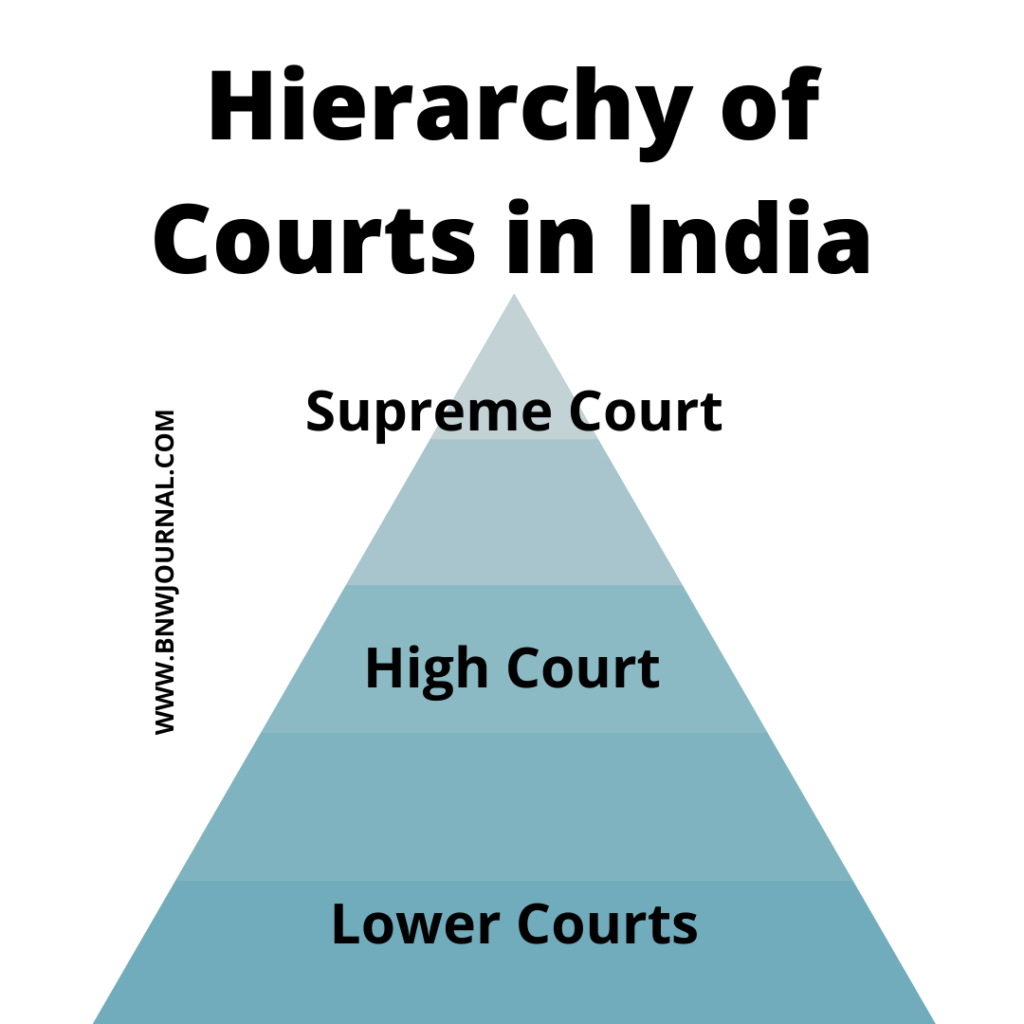![]()
Introduction
The ‘Rule of Law’ states that all individuals are subject to the same law irrespective of their economic status, or them belonging to the forward or backward class. The tool and the mechanism that ensures that there is equality and supremacy of law and that everyone is subject to the same law is the Judiciary of the country. The Judiciary performs the important function of interpretation of the laws; however, the Judiciary has no right to frame or make laws. They play the role of resolution of disputes and ensure the speedy delivery of justice.
Each country has its constitution of the Judiciary. India is no different. It has an integrated system that is subject to the Constitution of India. The Judiciary acts as the protector of the fundamental rights and the guardian of the Indian Constitution. The Indian Judicial System is pyramidal in structure as depicted below. Further, India follows the adversarial litigation system in which the Court acts as a neutral impartial party; and both the parties present their arguments as well as evidence with regards their sides.

Supreme Court of India
The Supreme Court or the Apex Court is the foundation or the base stone of the Judiciary of India. The Apex Court has its power vested in it through Article 124(1) of the Indian Constitution; the article entails that there is a Supreme Court of India that will constitute the Chief Justice of India. At an initial phase, the Supreme Court of India would consist of the Chief Justice and seven other judges. The Parliament by law may increase or decrease the number of judges of the Supreme Court as and when required. As of present, there are 34 judges including the Chief Justice of India.
Appointment of Judges
The President of India appoints the judge of the Supreme Court; and later seeks a consultation with the Chief Justice of India as well as the existing judges of the Supreme Court regarding the appointment. For the appointment of the Chief Justice of India, the President has to first consult the judges of the Supreme Court and the High Courts. For the eligibility of a person to be a Supreme Court Judge, the following criterion needs to be fulfilled:
- He/ she must be a citizen of India, should have been a judge of the High Court or two or more such Courts in succession for at least five years.
- He/ she should have the experience of practicing as an advocate of the High Court for the last ten years, or he should have been serving as the Judge of the High Court for a minimum period of five years else he should be considered as a distinct jurist by the President.
- Any Judge of the Supreme Court can perform his duties till the age of sixty-five years if he has not resigned or did not get disqualified or proved incapable of holding his office.
The Constitution has a provision wherein the judges can be appointed on an ad hoc basis, when required. Article 127(1) of the Constitution deals with the appointment of ad hoc judges. These judges are appointed for a particular purpose; for example if there is no Coram available to hold session then ad hoc judges are appointed. The Chief Justice also has the right to appoint to High Court Judge as an ad hoc judge after a consultation with the Chief Justice of the High Court concerned.
Power and Jurisdiction of the Supreme Court
The Jurisdiction of the Supreme Court falls under the following categories-
- Original Jurisdiction: The Supreme Court exercises the power of Original Jurisdiction in exclusivity to cases involving disputes between the State Governments and the Central Government. The Supreme Court has Original Jurisdiction but this Jurisdiction is not exclusive for the enforcement of Fundamental Rights.
- Appellate Jurisdiction: The Supreme Court has the inherent jurisdiction of hearing appeals raised over the judgments of the High Courts provided the Court under which the dispute was raised grants a certificate related to the query about its interpretation.
- Advisory Jurisdiction: The Supreme Court has been rendered with the power to report to the president about any question that has been raised which is of great public importance.
High Courts
These Courts are the courts that are of secondary importance and are subordinate to the Supreme Court. These Courts majorly consist of appeals from Trial Courts and writ petitions conferred on them as under Article 226 of the Indian Constitution. Such Jurisdictions by Writs are Original Jurisdictions of the High Court.
Article 141 of the Constitution of India that imposes the Doctrine of Precedent also implies that there would be lower courts thus establishing the High Courts. This article mentions that the Supreme Court judgments can act as precedents and can be binding upon the lower courts. Article 216 of the Constitution establishes High Courts as Constitutional Courts.
Appointment of Judges
The Appointment of High Court Judges is done by the President of India with the consultation of the Chief Justice of India along with the Governor of the State. The President has the authority to fix the number of judges as per the requirement of the High Court.
Jurisdiction of High Courts
The Jurisdiction of the High Court extends to all the states, groups of states as well as the Union Territories. As per the Doctrine of Precedent, they also have the power to govern over the jurisdiction of subordinate courts. The High Court is considered as the principal civil court. But, the High Court exercises its Original Civil and Criminal Jurisdiction only when the subordinate courts are not competent to resolve such a matter.
Lower Courts/ Subordinate Courts/ District Courts
The District Courts operate within the districts of the country. It is the discretion of the respective State Governments or Union territory’s Government to decide the number of courts to be in that particular state or the Union Territory. Such a decision is made depending upon the number of cases and the population distribution in that district. These Courts administer justice at the state level. However, an erroneous decision of the District Court can be further appealed to a subsequent High Court.
Jurisdiction of District Courts
The District Court exercises both Original and Appellate Jurisdiction. The District Courts also have principal Civil and Criminal Jurisdiction. Civil Jurisdiction is derived from the concerned state enactments. For, a criminal matter the Jurisdiction is derived from the Code of Criminal Procedure. A District or Sessions judge can award a maximum sentence of Capital Punishment.
CONCLUSION
It often comes to question as to whether the three-layered judicial system would be necessary for running an effective judiciary. However, it becomes very evident that the country has a strong foundation for resolving legal disputes and the utility of the system has been long proved. Therefore, India does need a complex system of judicial process to ensure the best shot of justice for its citizens.



0 Comments